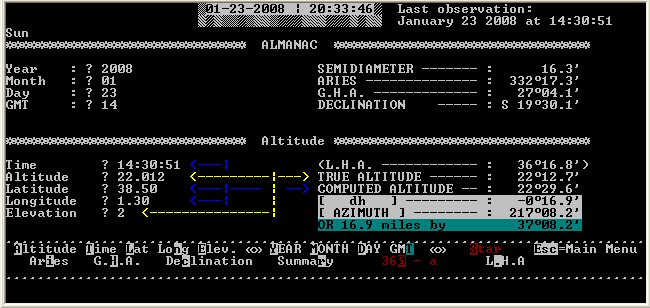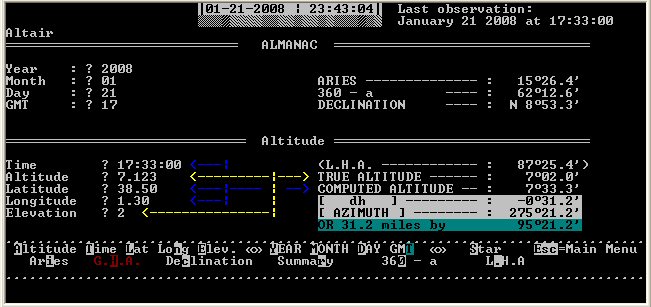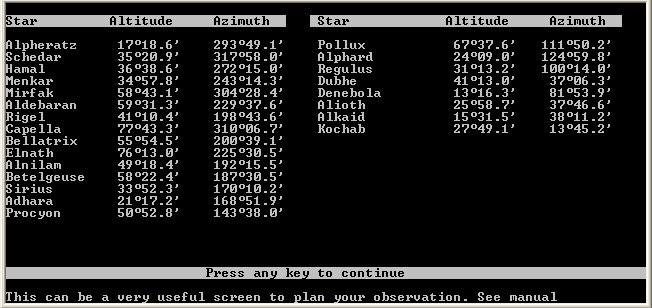
Astronavigation
by Marco Livraghi

Astronavigation is a little program to greatly simplify the task of finding your position at sea with a sextant.
It calculates the coordinates of the Sun and of Aries, from which the coordinates of the 57 navigational stars are also calculated.
It can also be used for planets, but you have to input the coordinates for them (on the hour) as found in the printed almanac or in many astronomical programs.
It looks like this:

One good thing about it, it takes less than one second from when you open the program to get this screen. Just keep Enter pressed for about half a second. It will give you the sun's situation at your location and at your computer's local time (provided you've used it at least once and told it your lat/lon and time zone - otherwise it will give you the sun's situation at my location and with my time zone).
If you like to work with a sextant, this little program will let you do it fast and easy.
It won't do much else, but to draw position lines easily, I haven't seen anything like it.
The bad thing about it, it doesn't do the moon (well, I can never get a good sight of the wretched thing anyway) and for the planets (of which you do get good sights) you need an almanac. You also have to update the stars you use every few months or so.
Well, I'll do the rest of the work some day.
But as it is, for sun and stars, it's as easy to use a you can get.
And for planets, if you do have an almanac. it's still very handy.
Ok, it doesn't do the moon, but
Another good thing about it, is it's very good for studying navigational astronomy, as it will give you a quick and easy check of any calculations you're doing.
So if there's an error in your calculations, it's very easy to spot.
For example, if you press "." (dot) for the L.H.A. from your Stars screen,

You get the breakdown of the L.H.A. by its components:
star's coordinates and longitude plus minutes/seconds on the hour:

Add them all up, check the results (and the data) on the screen, you know if you're doing something wrong, and what.
Other goodie: the Twilights screen:

This is the evening twilight on June 22nd, 2008.
All the stars between 5 and 80 degrees over the horizon are listed.
You have lots of nice bright stars, nicely spaced out, at very comfortable altitudes.
Go get them. That's the difficult part.
Once you've got them, you'll see just how easy it will be to work out a position from them.
So then if you want to try it, you can download it here. (70KB including the manual and all)
If you just want to look at the manual, you have it here, in Word format, or here in plain text.
The program is FREE for non-commercial use.
If you are the captain of the QE2 and use it a lot, you're cordially invited to invite me on board for a drink next time you're in port, otherwise I guess it's free for all.
Source code:
This is written in QuickBasic.
The code is freely available. Just ask for it.
Bear in mind that I am a sailor, not a programmer. So if you find the code "inelegant" (actually itís quite messy) donít blame my programming skills. I havenít got any.
It is quite extensively commented, though, so the relevant parts should be quite easy to follow.
The contact information is in the manual.
My mummy didn't tell me not to write my e-mail address on web pages, no.
I had to learn it myself.